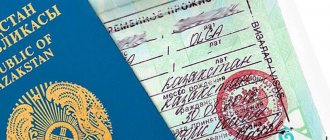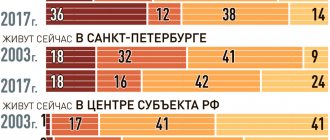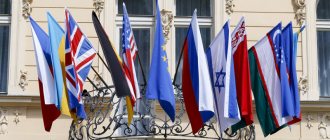HomeNews ATOR Bulletin
17.02.2020
From January to December 2021, foreigners made 32.9 million visits to Russia. This is approximately the same as in 2021 – the increase was 0.98%. However, the number of foreigners visiting Russia for tourism purposes increased over the year by 20.5% and amounted to 5.1 million people.
The Border Service of the FSB of the Russian Federation has uploaded the latest data on the entry of foreign citizens into Russia. At the end of 2021, 32,866,137 citizens of foreign countries entered the Russian Federation, which is only 0.98% (315.6 thousand) more than in 2021.
The number of visits from Ukraine, which ranks first in terms of the number of entries for various purposes, continues to decline. In 2019, Ukrainians came to Russia 8.7 million times. This is almost 6% less than a year earlier.
Almost all other countries in the TOP 10 (mainly CIS countries and former USSR republics) show an increase in the number of visits. The number of visits from Kazakhstan increased by 1.7% (to 4.3 million), from Uzbekistan - by almost 10% (2.6 million). The top 10 also included: China (2.3 million, +11.2%), Tajikistan (1.6 million, +17.6%), Azerbaijan (1.2 million, +2.5%), Kyrgyzstan (959.1 thousand, +11.6%), Finland (938.7 thousand, -5.6%), Armenia (816.5 thousand, minus 1%), Germany (744.5 thousand, +6.1%).
The vast majority of the listed countries are not suppliers of classic tourists to Russia. Foreigners from the TOP 10 countries come for the purpose of work, personal business, shopping, visiting relatives, etc.
Among the top ten, only China and Germany are major suppliers of tourists. At the same time, out of 2.3 million, only 1.5 million Chinese indicated tourism as the purpose of their visit to Russia.
ENTRY TOURIST FLOW INCREASED BY 20.5%
Last year, foreigners made 5,061,696 visits to Russia, indicating tourism as the purpose of their trip (+ 20.5% to the corresponding figures for 2021). Thus, at the end of 2021, almost one fifth more foreign tourists visited Russia than in 2018.
The TOP 5 main suppliers of tourists has not changed compared to 2021. The largest number of tourists, according to the FSB, came from China - 1.5 million. Tourist flow from China increased by almost 19%.
Let us recall that 1.2 million Chinese citizens visited Russia through the “visa-free channel” as part of tourist groups. Most of them (750 thousand) vacationed in Moscow and St. Petersburg. Another 170 thousand visits were recorded in 2021 by the Primorsky Territory, 116 thousand by the Amur Region, 38 thousand by the Trans-Baikal Territory, 15.1 thousand by the Khabarovsk Territory.
TOP 10 key inbound tourism markets in Russia by volume of visits for tourism purposes (number of trips in 2019)

Source: data from the Border Service of the FSB of Russia
Germany ranks second in terms of the number of tourists. Over the year, citizens of this country made 522.2 thousand visits to Russia, which is 15.7% higher than in 2021.
In third place is South Korea. In 2021, tourist flows from this country increased by 20.8% and amounted to 413.6 thousand.
The flow of tourists to Russia from the United States continues to grow. Last year, Americans made 241.1 tourist visits to Russia, up 6% from the year before.
Israel closes the TOP-5 – 199 thousand tourist visits per year and an increase of +21.7%.
Dynamics of growth in the number of tourist visits for the TOP 10 key markets (annual increase in the number of trips, in%, in 2019 compared to 2021)

Source: data from the Border Service of the FSB of Russia
The second half of the top ten major tourism donors for Russia in 2021 has undergone some changes. In sixth place, as a year earlier, is Italy. Data for this country once again confirms the trend towards restoration of tourist flows from Europe to Russia - in 2021, 154.8 thousand visits were recorded from Italy (an annual increase of +22%).
Seventh place with an increase in tourist flows of 32.4%, displacing the UK to a lower position, was taken by France in 2021. In total, in 2019, the French made 154.3 tourist visits to Russia.
Tourist flows from the UK grew by only 6.5% and amounted to 133.8 thousand in 2019.
The last two positions of the TOP-10 remained unchanged - in ninth place, as in 2021, is Spain (110.9 thousand, an increase of 30%), in tenth is Japan (80.3 thousand, an increase of 31.2%) .
The number of large suppliers of tourists to Russia in 2021 also included India (76.8 thousand, +46%), Estonia (69 thousand, +74%), Finland (67.7 thousand, +21%), Latvia (60 thousand, +61%), Thailand (59 thousand, +15%), Lithuania (57 thousand, +137%), Turkey (51.7 thousand, +11.2%), Australia ( 51.1 thousand, +9.4%). The tourist flow from other countries at the end of the year was less than 50 thousand.
Islamization of migrants in Russia is a myth

But what our Central Asian colleagues often talk about when studying migration to Russia is that migrants here are allegedly being overly Islamized. For the authorities of the former Soviet republics, this is really a big fear; they talk about it often and a lot, and conduct additional control over citizens returning from Russia.
But here it is necessary to understand that in a number of republics, in principle, the state closely monitors its citizens; they do not feel free in their homeland. Once in Russia, some migrants actually get the opportunity to study some kind of thematic literature that is prohibited in their homeland, and listen to preachers.
But in practice: does everyone have enough time to visit radical imams in Moscow or carefully study this issue on the Internet? And how many imams and Internet sites do we have that are not controlled by the relevant competent authorities?
And the fact that migrants can communicate with immigrants from the North Caucasus, who consider themselves more savvy in theology, is because our Caucasians themselves do not intersect with them so often and communicate without much desire.
Of course, among the millions of migrants there will be radicals, GTA gangs, and a killer nanny. But this does not mean that we need to generalize, it’s the same as calling all Russians drunkards.
It's the same with crime.
The main crime of migrants is often a violation of the visa regime and migration legislation. But there is no more real crime in the common sense, and even less in percentage terms.
It’s just that each such case, as a rule, is covered in detail and there is a resonance in the press. Typically, migrants prefer to behave, as they say, quietly and below the grass, because they understand that any offense can become a one-way ticket for them.
ASIA IN PLUS, LATIN AMERICA IN MINUS
At the end of the year, almost all countries showed an increase in tourist flows to the Russian Federation, the number of visits from which exceeded 10 thousand.
Predictably, 2021 demonstrated a decrease in tourist flows to the Russian Federation from Latin American countries. During the 2018 FIFA World Cup, many fans came to Russia from these countries, but this flow did not become stable. Statistics from the FSB Border Service show: the number of visits from Brazil in 2021 decreased by 4.6% (to 38 thousand), from Argentina - by 27% (to 19 thousand), from Colombia - by 8.6% (to 12 .6 thousand), from Peru - by 33% (up to 5.7 thousand).
At the same time, the flow of tourists from Asian countries was actively growing in 2021. More tourists came to Russia from China, South Korea, Japan, India, Thailand, Hong Kong (22.5 thousand, +1%), Vietnam (21.3 thousand, +56.5%), Indonesia (16.8 thousand, +74.8%), Taiwan (14 thousand, +33.7%), Malaysia (11.4 thousand, +42%).
Temporary foreign migration to Russia[ | ]
Labor migration[ | ]
This is also facilitated by the fact that until 2002 in Russia there was no legislation on migration that met minimum standards. Among the non-CIS countries, the largest number of migrants to Russia comes from China, as well as Vietnam, Afghanistan, and Turkey.
In the first quarter of 2010, a decrease in migration growth was noted in population exchanges with CIS member states. Citizens from EAEU member countries (Kazakhstan, Belarus, Armenia, Kyrgyzstan) do not need to buy a patent to work in the Russian Federation; they have been equal in labor rights to citizens of the Russian Federation. An increase in growth was observed in migration exchange with the Republic of Moldova, Ukraine, Azerbaijan, and Tajikistan[15].
For 9 months of 2013, 3.3 million foreign labor migrants entered Moscow and the Moscow region alone, and 2.5 million labor migrants entered St. Petersburg and the Leningrad region[7].
Illegal foreign labor migration[ | ]
In 2006, a law was adopted that significantly simplifies labor migration from states whose citizens enter Russia without visas. In particular, to hire such a foreign citizen, the employer does not have to obtain the prior consent of the Federal Migration Service. Since 2013, the quota system for migrants has been abolished, and a system for migrants to purchase work patents has been introduced.
In July 2013, the head of the Federal Migration Service, K. Romodanovsky, reported that over 3.5 million foreign citizens are currently working illegally in Russia, and only more than 1.8 million are working with valid work permits and patents.
Due to low salaries and the high cost of work patents (4,000 rubles/month in Moscow), for most visa-free foreign migrants it is more profitable to work illegally (within 90 days of the permitted stay of a foreign citizen on the territory of the Russian Federation, for a period of six months). After 90 days, migrants briefly leave the territory of the Russian Federation and soon return to illegal earnings for the next 90 days[16].
Countries from which migrants came to Russia (2012-2013)
In 2012 and 2013, according to Rosstat, the distribution of migrants by country from which they came to Russia was as follows[17]:
| Uzbekistan | ||
| 2 | 49,4 | Ukraine |
| 3 | 45,5 | Kazakhstan |
| 4 | 41,7 | Tajikistan |
| 5 | 37,0 | Armenia |
| 6 | 34,6 | Kyrgyzstan |
| 7 | 23,6 | Moldova |
| 8 | 22,3 | Azerbaijan |
| 9 | 16,6 | Belarus |
| 10 | 8,5 | China |
| 11 | 7,7 | Georgia |
| 12 | 5,4 | Turkmenistan |
| 13 | 4,2 | Germany |
| 14 | 1,4 | Latvia |
| 15 | 1,1 | USA |
| 16 | 0,8 | Lithuania |
| 118,1 | Uzbekistan | |
| 2 | 55,0 | Ukraine |
| 3 | 52,0 | Kazakhstan |
| 4 | 51,0 | Tajikistan |
| 5 | 42,4 | Armenia |
| 6 | 30,4 | Kyrgyzstan |
| 7 | 28,7 | Moldova |
| 8 | 23,5 | Azerbaijan |
| 9 | 15,7 | Belarus |
| 10 | 8,1 | China |
| 11 | 7,7 | Georgia |
| 12 | 6,0 | Turkmenistan |
| 13 | 4,2 | Germany |
| 14 | 1,5 | Latvia |
| 15 | 0,9 | USA |
| 16 | 0,9 | Lithuania |
Internally displaced persons (refugees)[ | ]
In the first quarter of 2010, 853 people received forced migrant or refugee status from the territorial bodies of the Federal Migration Service of Russia (in the first quarter of 2009 - 2,516 people). The share of registered forced immigrants in the total number of arrivals from outside the Russian Federation was 0.09%.
According to the Federal Migration Service of Russia, as of April 1, 2010, there were 56.7 thousand forced migrants and refugees in the country. More than 35% of them (19.8 thousand) were former residents of Kazakhstan, 19% (10.6 thousand) - Georgia, 12% (7.0 thousand) - Uzbekistan, 5% (3.0 thousand) - Tajikistan. More than 12 thousand people (21%) moved within Russia from regions with an unstable socio-political situation.
The process of resettlement of forced migrants is ongoing in all constituent entities of the Russian Federation. The largest number of forced migrants and refugees chose the Republic of North Ossetia-Alania as their new place of residence (10.7 thousand people), 6.5 thousand - the Republic of Ingushetia, 2.8 thousand - the Belgorod region, from 2.0 thousand to 1 .6 thousand - Samara and Orenburg regions, Krasnodar and Stavropol territories, from 1.3 to 1.1 thousand - Nizhny Novgorod region, Altai region, Kemerovo, Novosibirsk and Volgograd regions[15].
Illegal immigration[ | ]
In 2000, 21.2 million foreign citizens entered Russia, and 17.9 million people left. In 2004 - 21.2 and 20.8 million people, in 2005 - 20.9 and 19.8 million people, in 2006 - 21.2 and 19.9 million people, respectively. Many foreigners who enter Russia subsequently remain on Russian territory, in violation of migration laws, and become classified as illegal migrants[18].
According to a UN report published in 2002, Russia was in second place (after the United States) in the number of legal and illegal migrants living in the country. According to UN experts, there are more than 13 million people in Russia. - 9% of the population.
In November 2014, according to the head of the Federal Migration Service of Russia, Konstantin Romodanovsky, about 3 million foreign citizens were illegally staying on the territory of the Russian Federation, significantly exceeding the period of legal stay on the territory of the Russian Federation (90 days)[19][20].
Opinions[ | ]
There are two opposing points of view on attracting immigrants and foreign labor migrants:
- Attracting foreign labor migrants will increase the competitiveness of the Russian economy due to low-skilled but very cheap labor. Through replacement immigration (300 thousand people per year), it was proposed to compensate for the natural decline in the working population of Russia[21]. At the same time, it was not indicated what the purpose of increasing the population was in the context of the falling standard of living of the Russian population since 2014.
- Attracting unskilled migrants does not contribute to an increase in GDP per capita and the growth of the Russian economy, since migrants are mainly employed in low-skilled labor in technologically backward sectors of the economy[22]. Economic growth in the long term can only occur through the modernization of outdated industries, increasing their technological level - that is, including through increased qualifications, increased wages and purchasing power of the population. But the arrival of low-skilled migrants increases the share of the population with low qualifications and low wages. It is noted that Russia is still characterized by a high level of hidden unemployment - work in organizations with a deliberately low level of wages, and not making great demands on the qualifications of employees.[23] Thanks to labor migrants (legal and illegal), Russia maintains a low level of wages, which benefits only their employers, due to non-payment of taxes and pension insurance contributions from the salaries of guest workers, and leads to the loss of jobs by local specialists. Low wages also contribute to the transition of the population, following guest workers, into shadow employment (which constitutes more than 20% of the economically active population of Russia in 2015), considering it as an alternative to unemployment[24][25][26].







